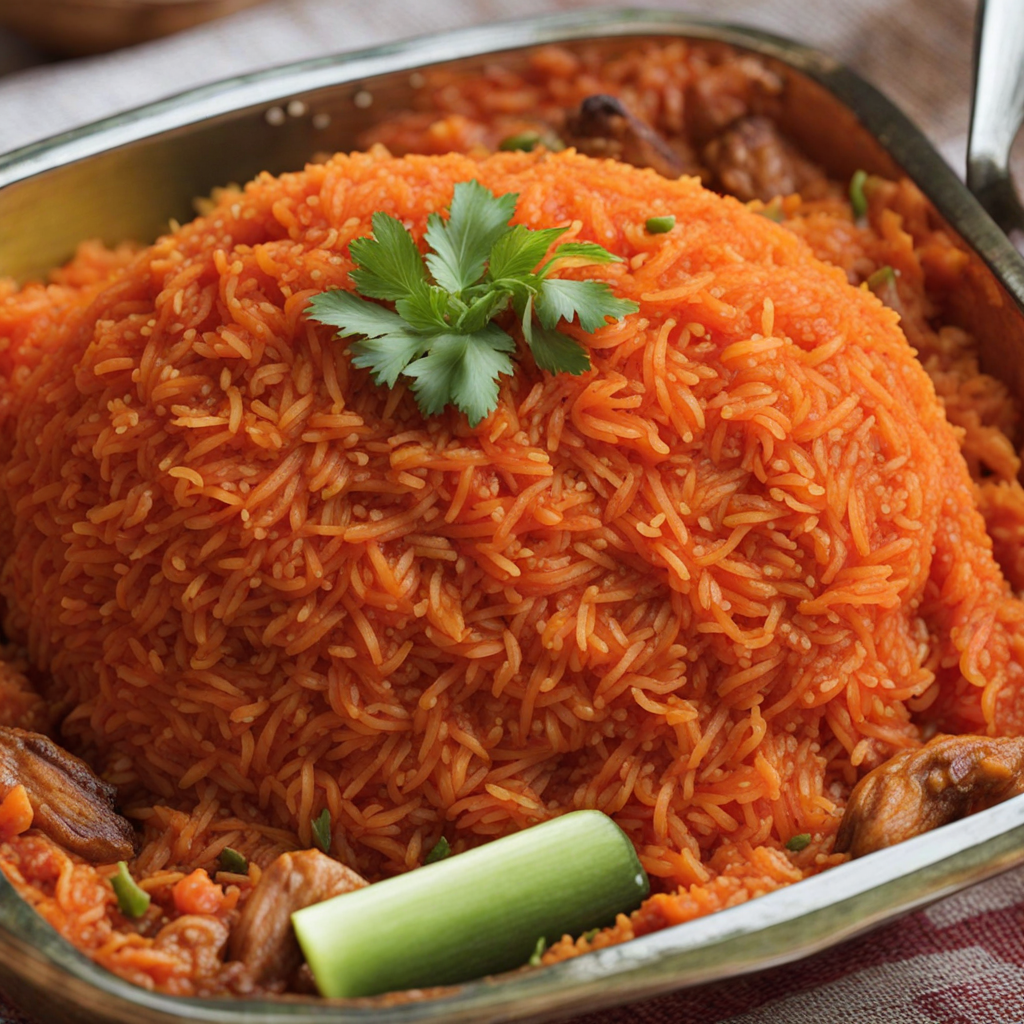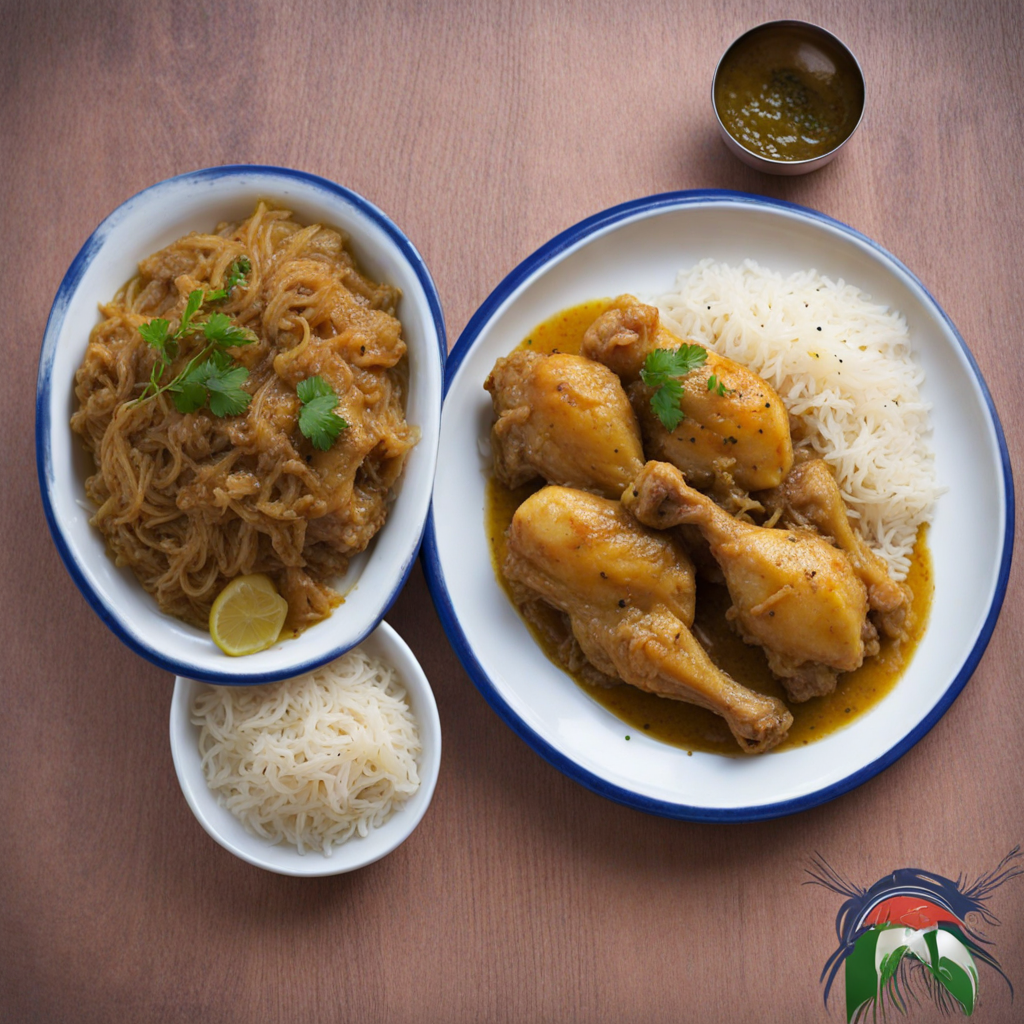Jollof Rice
Jollof Rice from Guinea-Bissau is a vibrant and flavorful dish that serves as a cornerstone of West African cuisine. This one-pot meal is characterized by its rich, red hue, which comes from the base of tomatoes, onions, and bell peppers that are blended and cooked down to create a savory sauce. The rice is then added, simmering in this aromatic mixture, allowing it to absorb the deep flavors. Each region may have its own twist, but the essence remains the same: a comforting, hearty dish that brings people together around the dining table. The unique charm of Guinea-Bissau’s Jollof Rice lies in its use of local spices and ingredients, which can include bay leaves, garlic, and sometimes a hint of chili for those who enjoy a bit of heat. The dish is often enhanced with proteins such as chicken, fish, or shrimp, which are typically marinated and then cooked alongside the rice, infusing it with even more flavor. Vegetables like peas and carrots might also be tossed in, adding color and texture, contributing to the overall experience of the meal. Jollof Rice is more than just a dish; it's a celebration of community and culture. Often served at gatherings, weddings, and festivals, it embodies the spirit of togetherness. The dish is frequently accompanied by fried plantains or a fresh salad, creating a balanced meal that is as visually appealing as it is delicious. For those looking to explore new flavors, Jollof Rice from Guinea-Bissau is a delightful introduction to the rich culinary heritage of West Africa.
How It Became This Dish
The Engaging History of Arroz de Jollof from Guinea-Bissau Arroz de Jollof, a vibrant and flavorful rice dish, holds a special place in the culinary heritage of Guinea-Bissau and is part of a broader West African tradition. While the dish shares its name with the more widely recognized Jollof rice of Nigeria and Ghana, it carries its unique history and cultural significance that reflect the diverse influences and traditions of the region. #### Origins of Jollof Rice The origins of Jollof rice are a subject of much debate among food historians, with various theories attempting to pinpoint its beginnings. Most scholars agree that Jollof rice traces its roots to the Wolof people of Senegal, where the dish, known as "Thieboudienne," was first created. The name "Jollof" itself is believed to be derived from the Wolof word "Jolof," which refers to an ancient kingdom that existed in the region. As trade routes flourished across West Africa, the dish traveled from Senegal to neighboring countries, adapting along the way to incorporate local ingredients and culinary techniques. In Guinea-Bissau, Arroz de Jollof has evolved into a beloved staple, characterized by its rich, tomato-based sauce, fragrant spices, and the inclusion of vegetables and proteins such as chicken, fish, or beef. The dish embodies the agricultural bounty of the region, where rice is a staple crop and tomatoes, peppers, and onions are abundantly grown. #### Cultural Significance Arroz de Jollof is more than just a meal in Guinea-Bissau; it is a symbol of community, celebration, and identity. The dish is often served during significant social gatherings, including weddings, birthdays, and religious festivities. Preparing Arroz de Jollof is often a communal affair, where family and friends come together to cook and share stories, reinforcing bonds and cultural ties. The way Jollof rice is enjoyed in Guinea-Bissau also speaks to the country's cultural values. Traditionally, the dish is served in a communal bowl, with diners using their hands to scoop the rice alongside their choice of meat or fish. This practice fosters a sense of togetherness and promotes the idea that food is meant to be shared—a core principle in West African hospitality. Moreover, in a broader context, Jollof rice has gained a significant cultural status among West African nations, serving as a point of pride and a subject of friendly rivalry. Each country claims its unique version of the dish, which has led to playful debates over which nation makes the best Jollof rice. This culinary competition has not only fostered a sense of community among West Africans but has also captured the interest of the global food scene. #### Development Over Time As Guinea-Bissau has navigated its historical landscape, so too has Arroz de Jollof evolved. The 15th and 16th centuries marked the arrival of Portuguese colonizers in the region. Their influence brought new ingredients and cooking methods, which enriched the local cuisine. The introduction of spices, such as paprika, and cooking techniques, such as sautéing, became integral to the preparation of Arroz de Jollof, creating a fusion of flavors that are cherished today. In the wake of independence from Portuguese colonial rule in 1973, Guinea-Bissau underwent significant political and social changes. Food became a means of expressing national identity and solidarity among the people. Traditional dishes like Arroz de Jollof were celebrated not only for their flavors but also for their ability to unite people in a shared cultural experience. Festivals and culinary events began to emerge, highlighting traditional recipes and bringing attention to the rich agricultural practices of the country. In contemporary Guinea-Bissau, Arroz de Jollof has also adapted to changing tastes and global influences. Urbanization has led to a greater diversity of ingredients, with chefs incorporating international flavors and techniques while staying true to the traditional essence of the dish. The rise of the culinary tourism sector in West Africa has further popularized Arroz de Jollof, with visitors seeking authentic gastronomic experiences. #### Ingredients and Preparation The preparation of Arroz de Jollof is a labor of love, and while recipes may vary from household to household, the essence remains consistent. The dish typically begins with the preparation of a base sauce made from tomatoes, onions, and peppers, often cooked down to create a rich, thick consistency. This base is seasoned with a medley of spices, including garlic, ginger, and bay leaves, which impart depth and complexity to the dish. Once the sauce is ready, rice is added, along with a choice of protein—such as chicken, shrimp, or fish—and sometimes an array of vegetables like carrots and green beans. The ingredients are then simmered together, allowing the flavors to meld and the rice to absorb the vibrant sauce, resulting in a colorful and aromatic dish. The beauty of Arroz de Jollof lies in its versatility. Each home chef may have their own secret ingredient or method, contributing to the dish's evolving identity. Some might add coconut milk for creaminess, while others may incorporate local spices to give it a unique twist. This adaptability has allowed Arroz de Jollof to remain relevant and cherished across generations. #### Conclusion Arroz de Jollof from Guinea-Bissau is a dish steeped in history and cultural significance. As a symbol of community, celebration, and identity, it encapsulates the spirit of the Guinean people. From its origins in the ancient Wolof kingdom to its evolution through colonial influences and modern culinary trends, Arroz de Jollof is a testament to the resilience and creativity of West African cuisine. Today, as the world becomes increasingly interconnected, Arroz de Jollof continues to be a source of pride for the people of Guinea-Bissau and a delicious representation of their rich cultural heritage. Whether enjoyed at a family gathering or a festive celebration, this dish serves as a reminder of the power of food to bring people together, transcending borders and creating lasting connections.
You may like
Discover local flavors from Guinea-bissau







